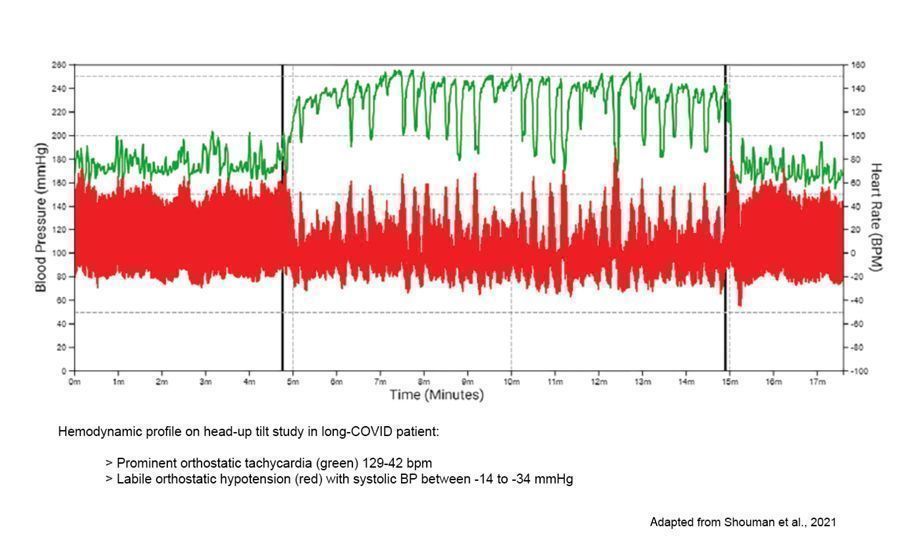HealthManagement, Volume 21 - Issue 4, 2021
Key Points
- Many patients who survive acute COVID-19 infection suffer from ongoing symptoms including breathlessness, palpitation, headache, chest pain, fatigue, pain, cognitive impairment, sweating, anxiety and depression.
- For COVID-19 long-haulers, symptoms can have a severe impact on their social life.
- Autonomic dysfunction is the trigger for many symptoms that can still be present months after a COVID-19 infection has been overcome.
- Easy autonomic function tests, such as the Active Standing Test, enable quick diagnosis and are essential for effective treatment.
Recent studies have revealed that in long COVID, patients suffer from autonomic dysfunction with persistent symptoms such as breathlessness, chest pain, palpitations and orthostatic intolerance long after post-acute infections. Easy diagnostic procedures and supporting management to patients will be required to handle the rapid increase in primary and secondary care consultations.
Diagnosing Long COVID
A recent study by the Mayo Clinic reported autonomic dysfunction in up to 63% of patients presenting with specific symptoms, after having survived a corona infection. Diagnosis was revealed by recording and evaluating beat-to-beat blood pressure and heart rate during head-up tilt tests.1
Experts from the Imperial College/London UK also confirm that active standing tests and tilt testing, with the help of continuous blood pressure and heart rate measurement, are essential tools for diagnosing autonomic dysfunction in long COVID patients,2 which is essential for appropriate treatment and recovery.
Basic research studies investigating the complex mechanisms of a COVID-19 infection also count on the continuous, non-invasive monitoring of blood pressure and hemodynamics, such as provided by the CNAP technology, in order to apply a multidisciplinary analysis of the cardiovascular status of the COVID-19 patient.3
However, although easy diagnosis and therapy control tools are available on the market, the current infrastructure is insufficient to cope with the existing long COVID patient population. More physicians familiar with the care of postural orthostatic tachycardia syndrome (POTS) and related autonomic diseases are definitely needed. As long as the waiting lists in tertiary care clinics with this expertise can be 6–12 months or longer, appropriate and timely diagnosis and treatment are impossible.4
Patients are Desperate and Need Encouragement
Many patients who have survived the acute COVID-19 infections suffer from ongoing symptoms resulting in a combination of breathlessness, palpitation, headache, chest pain, fatigue, pain, cognitive impairment, sweating, anxiety and depression.4,1 Studies report that 93% of these patients complain of lightheadedness.1 Many symptoms indicate orthostatic hypotension, POTS or even vasovagal syncope,2 caused by a dysfunction of the autonomic nervous system.

Well-known American newspapers such as the New York Times, the Wall Street Journal or the Atlantic have already addressed the fears of the so-called “COVID long-haulers” and give them a voice. Thousands of patients and their doctors are establishing support groups on the Internet or on social media channels (e.g. #longcovid on Twitter) to share experiences, find quick solutions2 or simply cry for help.
These patients are desperate, as symptoms have a severe impact on their social life. A recent study reports that six to eight months after having recovered from COVID-19, patients still suffer from residual autonomic symptoms. 60% are unable to return to work, only 15% have completely recovered.5
Quick Help Through Easy to Use Tools
Autonomic Dysfunction is the trigger for many symptoms that can still be present months after a COVID-19 infection has been overcome. This severely affects the quality of life of thousands of “COVID-19 veterans”. Easy autonomic function tests, such as a 10-minute ACTIVE STANDING TEST 4,5 or a short tilt table test,2 enable quick diagnosis and are essential for effective treatment. Established and easy-to-use methods and medical devices such as the Task Force® Touch platform by CNSystems for cardiovascular and autonomic assessment help to support these requirements to enable recovery from long COVID and a return to normal life.
Integrating autonomic testing might be the key for managing long COVID as the American Autonomic Society makes it very clear: “It will not be possible to address the needs of this population without a commitment not just from providers, but also hospitals and medical center administration.” 4
Disclosure of conflict of interest: Point-of-View articles are the sole opinion of the author(s) and they are part of the HealthManagement.org Corporate Engagement or Educational Community Programme.
References:
2. Dani, M. et al. Autonomic dysfunction in ‘long COVID’: rationale, physiology and management strategies. Clin. Med. J. R. Coll. Physicians London 21, E63–E67 (2021).
3. Bajić, D., Đajić, V. & Milovanović, B. Entropy Analysis of COVID-19 Cardiovascular Signals. Entropy (Basel). 23, (2021).
4. Raj, S. R. et al. Long-COVID postural tachycardia syndrome: an American Autonomic Society statement. Clin. Auton. Res. 1–4 (2021) doi:10.1007/s10286-021-00798-2.
5. Blitshteyn, S. & Whitelaw, S. Postural orthostatic tachycardia syndrome (POTS) and other autonomic disorders after COVID-19 infection: a case series of 20 patients. Immunol. Res. (2021) doi:10.1007/s12026-021-09185-5.







